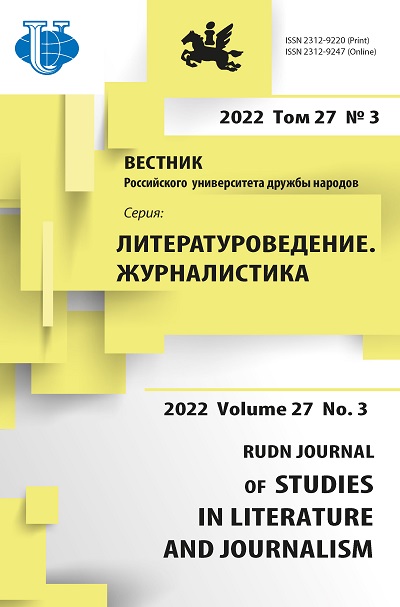Cosmogonoeschatological and Easter archetypes in the work of Daniil Kharms in the 1930s
- Authors: Korneev A.V.1
-
Affiliations:
- Tomsk State University
- Issue: Vol 27, No 3 (2022)
- Pages: 459-467
- Section: LITERARY CRITICISM
- URL: https://journals.rudn.ru/literary-criticism/article/view/32298
- DOI: https://doi.org/10.22363/2312-9220-2022-27-3-459-467
Cite item
Full Text
Abstract
The research is devoted to the dynamics of D.I. Kharms’ creativity in the 1930s: if his early work functions in accordance with the ideas of the cosmogonomeschatological archetype, then later he turns to the Easter archetype, especially in the story “The Old Woman” (1939), which can be described as the final point of abandonment of the avant-garde. The goal is to show the process of Kharms's transition from the cosmic-eschatological to the Easter archetype. This process in the work of Kharms is described for the first time. The research material is Kharms' works of the 1930s. The methodology is determined by modern theoretical ideas about the categories of archetype and myth. The transition from the cosmogonoeschatological archetype to the Easter archetype begins in the work of Kharms with the story “Morning” (1931), where Kharms focuses on describing everyday life, while the main motive in the story becomes the motive of waiting for a miracle that will never happen. This story differs from the previous works of Kharms and shows the writer's departure from the positions of his own philosophical treatises of 1927-1931 and from the type of thinking characteristic of the avant-garde - the cosmic-eschatological archetype. This leads to the destruction of the myth in his work as a picture of the world that explains the world, leads to the formation of a plot of doubt, the functioning of which leads to total incoherence and disunity in his poetics. The result is the story “The Old Woman,” in which the archetype of Easter is actualized, as a result of which the spiritual revival of the hero associated with the appeal to God takes place.
About the authors
Alexander V. Korneev
Tomsk State University
Author for correspondence.
Email: alexxlea2013@gmail.com
ORCID iD: 0000-0002-8021-2542
postgraduate student, Department of Russian and Foreign Literature
36 Prospekt Lenina, Tomsk, 634050, Russian FederationReferences
- Esaulov, I.A. (2008). Easter archetype of Russian literature as a factor in genre generation. Dergachevskie Chteniya: Conference Proceedings (pp. 164–173). Yekaterinburg. (In Russ.)
- Kharms, D.I. (2002). Notebooks. Diary. Book 1. St. Petersburg: Akademicheskii Proekt Publ.; 2002. (In Russ.).
- Kharms, D.I. (2011). Collected works. St. Petersburg: Azbuka Publ., Azubka-Attikus Publ. (In Russ.)
- Khomyakova, O.R. (2021). Conflict as a category of literary studies: Analytical research strategies. RUDN Journal of Studies in Literature and Journalism, 26(3), 501–510. (In Russ.) http://doi.org/10.22363/2312-9220-2021-26-3-501-510
- Kobrinskij, A.A. (2008). Daniil Kharms. Moscow: Molodaya Gvardiya Publ. (In Russ.)
- Korneev, A.V. (2021). The archetype of Easter in the story “The Old Woman” by Daniil Kharms. Filologicheskie Nauki. Voprosy Teorii i Praktiki, (7), 1969–1974. (In Russ.) https://doi.org/10.30853/phil210359
- Korneev, A.V. (2022). Metanoia of Daniil Kharms: A transition from cosmogono-eschatological to Christian myth and rejection of the avant-garde. Imagologiya i Komparativistika, (17), 98–111. (In Russ.) https://doi.org/10.17223/24099554/17/5
- Kozina, T.N. (2019). The evolution of the Easter archetype. Tambov: Yukom Publ. (In Russ.)
- Kuvshinov, F.V. (2014). Occultism in D.I. Harms creative activity. Vestnik KRAUNC. Gumanitarnye Nauki, (2), 14–18. (In Russ.).
- Losev, A.F. (2001). Dialectics of myth. Moscow: Mysl' Publ. (In Russ.)
- Shadrin, A.A. (2009). The reality of the borderline existence of “I” in “Myr” by Daniil Kharms. Izhevsk: Udmurt University. (In Russ.)
















